In the glass industry, the quality of refractory materials is of great significance for improving the quality of glass products, saving fuel, extending the lifespan of the glass furnace, and reducing the cost of glass production. Refractory materials are the material basis of glass furnaces. They have a great impact on the overall benefits of furnaces, and must be selected reasonably. The working conditions of different parts of the glass furnace are different, and the performance of refractory materials is also different. The basic requirements for refractory materials for glass furnaces are roughly as follows:
► Must have high refractoriness;
► No pollution or minimal pollution to glass liquid;
► Extend the service life as much as possible;
► There is no contact reaction between refractory materials of different materials at high temperatures;
► Precise style and size, as little dosage and heat loss as possible;
►Use high-quality materials for vulnerable parts and general materials for other parts.
However, glass furnace leakage accidents occur frequently, which bring huge economic losses to glass manufacturers. There are many reasons for glass furnace leakage accidents, including the aging of the furnace, the operation of workers, the design structure and process operation, and the quality of the fused cast AZS blocks. As a high-performance refractory material, fused cast AZS blocks are most widely used in the glass manufacturing industry, especially in the key parts of glass furnaces. This article will analyze the reasons for glass furnace leakage from the perspective of fused cast AZS blocks.
I Classification and current status of fused cast AZS blocks
II Causes and measures for leakage from bottom of glass furnace
III Causes and measures for leakage from side wall of glass furnace
I Classification and current status of fused cast AZS blocks
Fused cast zirconium corundum refractory products (Fused cast AZS blocks) are divided into three categories according to their nominal mass fraction of zirconium oxide:
|
Zirconia nominal mass fraction % |
Product Marking |
|||
|
JC493-2015 |
SEFPRO |
RHI |
ZAC |
|
|
AZS33-Y |
ER 1681 |
REFEL 1532 |
ZA 33 |
|
|
AZS36-Y |
ER 1685 |
REFEL 1334S |
ZA 36 |
|
|
AZS41-Y |
ER 1711 |
REFEL 1240 |
ZA 41 |
|
Fused cast zirconium corundum refractory products (Fused cast AZS blocks) are divided into four types according to the casting method:
|
Casting method |
Sign |
Explanation |
|||
|
|
JC493-2015 |
SEFPRO |
RHI |
ZAC |
|
|
Regular Cast |
RT |
RN |
N |
RC |
The shrinkage holes are basically aligned with the casting holes on the block surface, see Figure 1-1. |
|
Tilt Cast |
QX |
RO |
- |
TC |
Shrinkage holes are located close to the bottom of the block (used for side walls, rarely used) |
|
End Cast |
ZWS |
RR |
CR |
ENC |
Same as above, but with very few shrinkage cavities, see Figures 1-2~3 |
|
Void Free Cast |
WS |
RT |
PV |
VF |
There are no shrinkage holes in the blocks (the parts with shrinkage holes have been cut off), see Figures 1-4~6 |
1. Regular casting 2. End casting 3. End casting (special shape)
4. Void free casting (special shape) 5. Void free casting (paving blocks)
6. Void free casting
Although the production procedures of fused cast AZS blocks manufacturers are basically the same, the process control, process system, operating requirements and hardware supporting facilities are different. For example, the power of the transformer, the size of the electric furnace, etc., as long as there is a matching production process, high-quality fused cast AZS products can be made. However, whether the relevant process system, process control and operating methods are appropriate will directly affect the use effect of the product.
It is also particularly important to control the impurities in the raw materials during the production process of fused cast AZS blocks, so as to reduce the impurities in the products, reduce the content of glass phase, and increase the melting point of the products. The control measures are first to purchase high-quality raw materials, secondly to use strong magnets to remove iron in each operation process, and thirdly to control the increase of silicon content in the block materials. The bulk density and volume should be controlled by strengthening the good insulation effect after casting, configuring a sufficiently large riser, and artificially exhausting the molten liquid required for the block body to compensate for shrinkage, so that the bulk density of the product reaches more than 3.7. High-quality materials are the result of subtle process control and even greater investment.
II Causes and measures for leakage from bottom of glass furnace
Normally, the entire tank bottom is made of fused cast AZS #33 WS paving blocks with uniform thickness, which are placed on the insulation layer according to technical requirements. When the glass furnace is in operation, the erosion degree of each part of the tank bottom is different. After the fused cast AZS paving blocks in the seriously eroded parts are completely eroded, the insulation layer will be eroded faster, which will affect the safe operation of the glass furnace. Therefore, it is necessary to strengthen the anti-erosion performance of the material of the seriously eroded parts to achieve the effect of balanced damage to the entire tank bottom and ensure the safe operation of the furnace.
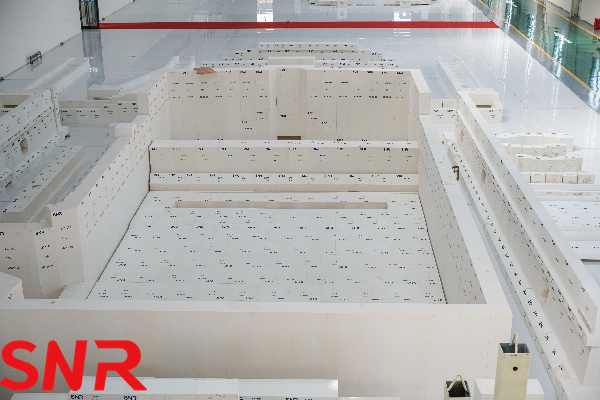
The biggest erosion of the tank bottom at the doghouse is mainly caused by the mechanical scouring of the material pile and the erosion of the metal substances contained in the glass raw materials drilling downward. In this area, the corrosion resistance of the material should be strengthened. The traditional fused cast AZS #33 paving blocks should be replaced with the more corrosion-resistant fused cast AZS #41 paving blocks.
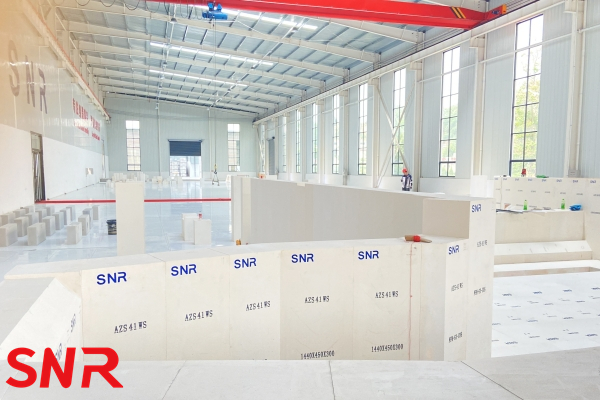

(2)Paving blocks at the bubbling
When the glass furnace adopts full insulation and bubbling technology, the temperature of the molten glass near the bubbling blocks is higher and the flow rate is greater. The tank bottom paving blocks on both sides of the bubbling blocks are relatively damaged. The traditional fused cast AZS #33 paving blocks should also be adjusted to more corrosion resistant fused cast AZS #41 paving blocks.

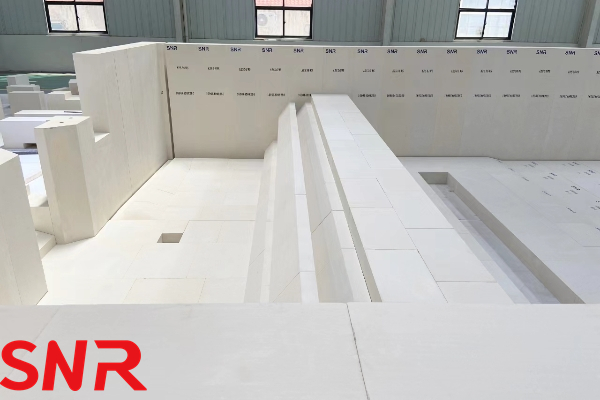
(3) Paving blocks at the electrode hole
The surface temperature of the molybdenum electrode at the bottom of the glass furnace can reach 2,000°C. The high temperature will cause serious corrosion to the electrode hole blocks. Therefore, the electrode hole blocks are made of fused cast AZS #41 blocks with better corrosion resistance. The tank bottom paving blocks around the electrode hole blocks are also seriously corroded by high temperature. The risk will be greatly reduced by adjusting the traditional fused cast AZS #33 paving blocks designed for this part to more corrosion-resistant fused cast AZS #41 paving blocks.
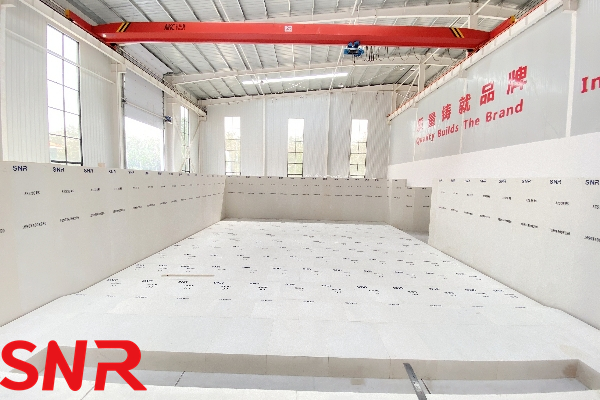

(4)Paving blocks at the throat
The throat is the centralized outlet of all glass liquid. The mechanical scouring of the glass liquid flow here not only impacts the throat side wall blocks and the throat cover blocks, but also the tank bottom paving blocks at the throat entrance are also mechanically scoured by the glass liquid flow. It is also particularly important to enhance the erosion resistance of the tank bottom paving blocks here. Fused cast AZS #41 paving blocks should be used here to balance the erosion state with other parts. Reasonable adjustment of the material of the glass furnace tank bottom will achieve better use effect and avoid safety hazards.

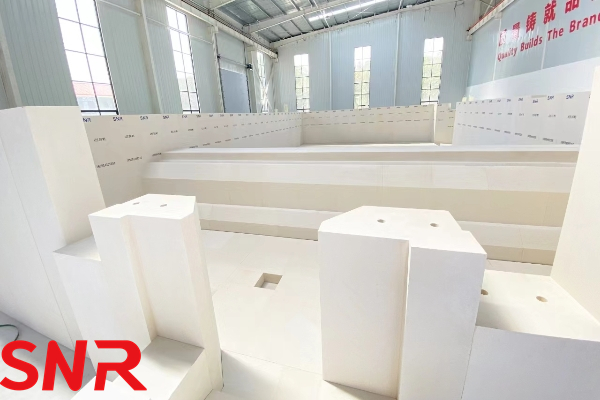
III Causes and measures for leakage from side wall of glass furnace
► Tilt casting side wall
At present, the number of users of tilt casting side wall is decreasing. The reason is that the quality of the product cannot meet the requirements of customers. It is not because of the tilt casting method, but because of the lack of production process and process system, which results in unqualified products. This unqualified product is not reflected in the industry standard. Tilt casting must be in an inclined state during casting, and the inclined angle must not be less than 25°.
Unqualified tilt casting is manifested in that the loose or hollow part inside the block body is large, which is a real safety hazard during use. The reason is:
(1) The casting tilt angle is not or is insufficient, resulting in looseness or increased void area inside the block body. The actual parameter of the casting tilt angle is 25°.
(2) The casting head is set at a lower position, and the edge of the casting head is even 200 mm away from the end face of the block body, which seriously affects the density inside the product. The actual parameter should be 50 mm from the edge of the casting head to the end face of the block.
(3) The casting head configuration is too small, and the molten liquid in the casting head cannot meet the molten liquid required for shrinkage compensation of the block body. The actual parameter is ¢200 mm × ¢300 mm × 300 mm in height.
(4) The second oxygen blowing after refining, continue to increase the furnace temperature after the second oxygen blowing, and cast after a few minutes. This process is a misunderstanding, which will cause a large amount of carburization in the product, and the product‘s resistance to glass liquid corrosion will be reduced. A large amount of carburization is a great hidden danger. The specific parameters are as follows: the first oxygen blowing starts after the raw materials in the furnace are fully melted, and the first oxygen blowing time is 5 minutes. Then, refining starts, and the refining time is 20 minutes. Then, the second oxygen blowing is carried out, and the oxygen blowing time is 2 minutes. After oxygen blowing, the raw materials stop melting and enter the casting process. The premise is that the furnace temperature in the melting and refining furnaces must be sufficient to make the casting temperature not lower than 1780℃. The tilting casting side wall is mainly to make the dense part of the casting bottom (the upper part when in use) as much as possible, and the casting head is placed closer to the upper part of the sand mold, the purpose is to facilitate more molten liquid to be added to the casting bottom and increase the density of the casting bottom.
►Void free casting side wall
One of the biggest safety hazards of the void free casting side wall is the internal looseness or voids. After cutting off the casting head, the looseness cannot be seen, and the appearance cannot be judged intuitively. As shown in Figures 3 and 4, the casting head is separated from the block body. From the fracture section, the color is slightly yellow or orange-red. The color is formed by oxidation after fracture under high temperature. In addition to being a funnel, the casting head has another main function. After the casting is completed, the molten liquid in the head has a shrinkage compensation
process for the block body. This shrinkage compensation process will last for 2.5~3 hours. The better the insulation effect and the longer the shrinkage compensation time, the higher the volume density of the product. After the casting gate is disconnected from the block body, it is oxidized by the outside world and quickly cooled and solidified, which stops the molten liquid in the casting head from replenishing the molten liquid required by the block body. The consequence is that the volume density is affected in a minor way. In serious cases, looseness or even holes will appear in the middle of the block body. Combined with the glass liquid leakage phenomenon in the glass furnace, it is not difficult to judge if it is due to material quality. This is one aspect.
The reason for the block body sinking is that the casting sand mold is placed on the casting frame bottom with 3 layers of
lightweight insulation bricks. The lightweight insulation bricks on the frame bottom are used to achieve the insulation effect of the bottom of the side wall blocks. Then the insulation material is placed in the insulation box. In order to make the insulation material and the casting sand mold tightly combined, it is necessary to vibrate the insulation sand in the insulation box to tightly protect the casting sand mold. Casting head and block body are separated and almost not connected. To avoid the block body sinking after casting, it is necessary to eliminate the block body sinking space. This sinking space is the combination of the casting sand mold, lightweight insulation bricks and frame bottom. By thickening the frame bottom, the
frame bottom itself has enough insulation layer thickness, and the casting sand mold is directly connected to the frame bottom, which avoids the space for the block body to sink. The frame bottom before improvement is shown in Figure 1, and the frame bottom after improvement is shown in Figure 2.
In summary, this article only analyzes the material causes of accidents at the bottom and side wall of the glass furnace. There are many other factors. Even the material analysis is not very comprehensive. There are still many problems to be solved. The refined improvement of fused cast AZS blocks can make it better in the use of glass furnaces.
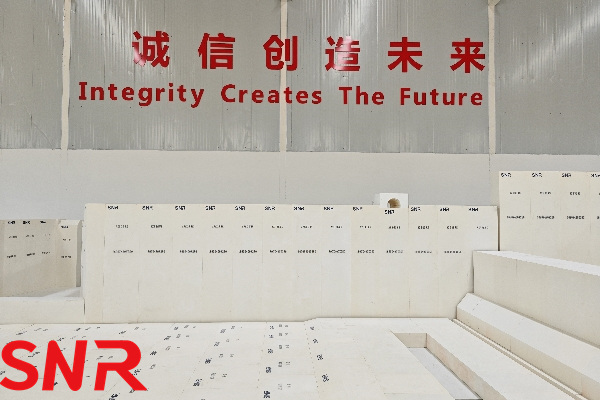

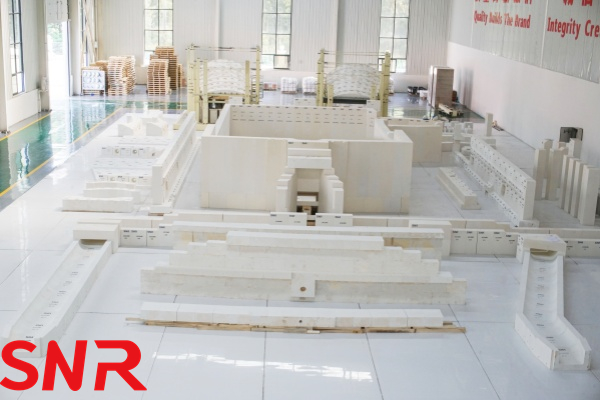
Henan SNR Refractory Co., Ltd. has been specializing in the production of fused cast AZS blocks for 30 years. We use high-quality raw materials and advanced fusion technology to provide customers with high-quality products. From raw material procurement to finished product delivery, every step is strictly quality inspected to ensure that every indicator meets the standards, so you can use it with confidence.
 If you have any needs, you can contact me at any time.
If you have any needs, you can contact me at any time.
Web:www.snr-azs.com
Email:wendy@snrefractory.com


